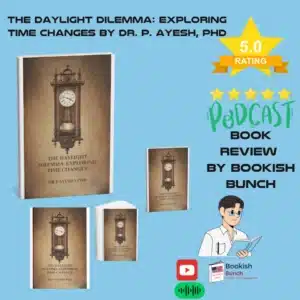The Daylight Saving Time Dilemma: How Time Changes Affect Health and Daily Life in 2024
Discover how Daylight Saving Time affects health, sleep, and daily life in 2024. Explore the growing debate over whether it’s time to stop changing our clocks in this review of The Daylight Dilemma.
 Every year, millions of people adjust their clocks twice for Daylight Saving Time (DST), but what impact does this age-old practice have on our health, productivity, and even the environment? As we approach Daylight Savings Time 2024, the debate is heating up.
Every year, millions of people adjust their clocks twice for Daylight Saving Time (DST), but what impact does this age-old practice have on our health, productivity, and even the environment? As we approach Daylight Savings Time 2024, the debate is heating up.
Should we still be changing our clocks, or is it time to move on from DST entirely? In this article, we’ll explore the Daylight Dilemma, the history of time changes, their effects on health, and the growing movement toward ending DST for good.
Affiliate Link: Buy The Daylight Dilemma on Amazon here
What is Daylight Saving Time, and Why Do We Still Do It?
Daylight Saving Time, introduced during World War I, was originally designed to conserve energy by extending daylight hours into the evening. In 2024, many people are asking if this practice is still necessary, especially with advancements in energy-efficient technology.
The time change, commonly known as Fall Back in November, sees clocks move back an hour, giving us more daylight in the morning but less in the evening.
The question remains: Is DST still useful today? Or are we simply following an outdated tradition that disrupts our health and daily routines?
The History of Daylight Saving Time
The origins of Daylight Saving Time trace back to 1784, when Benjamin Franklin jokingly suggested that people could save energy by waking up earlier. However, it wasn’t until World War I that the practice was formalized by Germany and quickly adopted by other nations, including the United States. By 2024, more than 70 countries observe some form of DST, although the benefits are increasingly being called into question.
The Daylight Dilemma dives deep into this history, offering insights into why the time change continues to persist even as more people advocate for its end.
How Daylight Savings Time Affects Your Sleep
 One of the most well-documented effects of Daylight Saving Time is its disruption of sleep. Whether it’s the springtime DST 2024 change (commonly known as “Spring Forward”) or the fall clock change, many people struggle with sleep issues. The sudden shift in time throws off our body’s natural circadian rhythms, leading to problems like insomnia, fatigue, and even more severe health issues.
One of the most well-documented effects of Daylight Saving Time is its disruption of sleep. Whether it’s the springtime DST 2024 change (commonly known as “Spring Forward”) or the fall clock change, many people struggle with sleep issues. The sudden shift in time throws off our body’s natural circadian rhythms, leading to problems like insomnia, fatigue, and even more severe health issues.
Research included in The Daylight Dilemma reveals that heart attacks spike by 24% in the week following the springtime clock change. The disruption also affects mental health, with increased cases of depression and anxiety reported after both time changes. This raises the question: Is an extra hour of daylight worth the toll on our health?
The Time Change Debate: Should We Abandon Daylight Saving Time?
As we approach Daylight Saving Time 2024, the conversation around whether or not we should continue changing our clocks is becoming louder. Critics argue that the minimal energy savings DST was meant to provide are no longer relevant in a world with advanced energy solutions like LED lighting and smart technology.
Others point to the negative impact on health and productivity. Studies show that time change 2024 can cause an increase in workplace accidents and road incidents due to sleep deprivation. Proponents of keeping DST often highlight the benefits of extended daylight in the evening, including lower crime rates and more time for outdoor activities. However, these benefits may not outweigh the downsides.
Global Perspectives on DST: Who’s Still Observing It?
Around the world, the approach to Daylight Saving Time varies widely. In Europe, countries like Germany and France observe DST, while countries like Russia and Japan have abandoned it entirely. In the U.S., some states, such as Arizona and Hawaii, have opted out of the clock change 2024, while others, including California and Florida, are pushing to make DST permanent.
The European Union has even considered scrapping DST altogether after widespread public dissatisfaction. The Daylight Dilemma provides a thorough exploration of how different countries handle the clock change and what the future may hold for time changes worldwide.
Health Impacts of the 2024 Time Change: More Than Just Lost Sleep
 The health risks associated with Daylight Saving Time go beyond a simple loss of sleep. Studies suggest that the biannual clock change can increase the risk of heart disease, stroke, and even obesity. The disruption to your body’s internal clock can also negatively impact mood, leading to a rise in cases of depression and anxiety during the weeks following the time change.
The health risks associated with Daylight Saving Time go beyond a simple loss of sleep. Studies suggest that the biannual clock change can increase the risk of heart disease, stroke, and even obesity. The disruption to your body’s internal clock can also negatively impact mood, leading to a rise in cases of depression and anxiety during the weeks following the time change.
This impact is particularly severe for people with pre-existing health conditions, making the argument for ending DST more compelling. As more countries consider abandoning Daylight Saving Time 2024, the conversation shifts toward finding better ways to manage time that doesn’t jeopardize public health.
Real Estate Dilemmas and Economic Impact
Interestingly, real estate dilemmas and the economic consequences of DST are often overlooked. The clock change can lead to scheduling confusion, which affects businesses, especially in sectors like real estate and transportation. Studies have shown that workplace productivity takes a significant hit in the days following the time change, leading to financial losses that outweigh the minimal energy savings.
The Daylight Dilemma also covers how businesses and industries are reacting to the growing movement to abolish DST, with some sectors pushing for more consistency in timekeeping.
Is It Time to Stop Changing the Clocks?
As public sentiment shifts, we may be approaching the end of Daylight Saving Time as we know it. In 2024, more countries and states are considering alternatives to this biannual disruption. Proponents of ending DST argue that a consistent timekeeping system would lead to better health, improved productivity, and fewer disruptions in daily life.
Whether you’re a fan of the longer summer evenings or tired of dealing with the negative impacts of the clock change, one thing is clear: Daylight Saving Time 2024 is at a turning point.
Affiliate Disclosure
This article contains affiliate links. If you click on one and make a purchase, we may earn a small commission, at no extra cost to you. Your support helps us continue to create valuable content like this.
Check out The Daylight Dilemma on Amazon
Conclusion: Should We Keep Daylight Saving Time?
The Daylight Dilemma offers a comprehensive look at how Daylight Saving Time affects our lives. From its historical origins to the health risks it poses, the book provides valuable insights for anyone interested in the future of timekeeping. As we move toward Daylight Saving Time 2024, it’s important to consider whether the benefits of this practice still outweigh the drawbacks.
If you’re curious to learn more about the effects of time changes on your health, productivity, and daily life, be sure to read The Daylight Dilemma. It’s a must-read for anyone questioning whether it’s time to stop changing the clocks for good.
